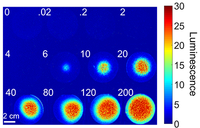当前位置:
X-MOL 学术
›
Phys. Rev. E
›
论文详情
Our official English website, www.x-mol.net, welcomes your
feedback! (Note: you will need to create a separate account there.)
Spatially propagating activation of quorum sensing in Vibrio fischeri and the transition to low population density.
Physical Review E ( IF 2.2 ) Pub Date : 2020-06-26 , DOI: 10.1103/physreve.101.062421 Keval Patel 1 , Coralis Rodriguez 2 , Eric V Stabb 2, 3 , Stephen J Hagen 1
Physical Review E ( IF 2.2 ) Pub Date : 2020-06-26 , DOI: 10.1103/physreve.101.062421 Keval Patel 1 , Coralis Rodriguez 2 , Eric V Stabb 2, 3 , Stephen J Hagen 1
Affiliation

|
Bacteria communicate by secreting and detecting diffusible small molecule signals or pheromones. Using the local concentrations of these signals to regulate gene expression, individual cells can synchronize changes in phenotype population-wide, a behavior known as quorum sensing (QS). In unstirred media, the interplay between diffusion of signals, bacterial growth, and regulatory feedback can generate complex spatial and temporal patterns of expression of QS-controlled genes. Here we identify the parameters that allow a local signal to trigger a self-sustaining, traveling activation of QS behavior. Using the natural bioluminescence of wild-type Vibrio fischeri as a readout of its lux QS system, we measure the induction of a spreading QS response by a localized triggering stimulus in unstirred media. Our data show that a QS response propagates outward, sustained by positive feedback in synthesis of the diffusible signal, and that this response occurs only if the triggering stimulus exceeds a critical threshold. We also test how the autonomous or untriggered activation of the V. fischeri QS pathway changes at very low initial population densities. At the lowest population densities, clusters of cells do not transition to a self-sensing behavior, but rather remain in communication via signal diffusion until they reach sufficiently large size that their own growth slows. Our data, which are reproduced by simple growth and diffusion simulations, indicate that in part owing to bacterial growth behavior, natural QS systems can be characterized by long distance communication through signal diffusion even in very heterogeneous and spatially dispersed populations.
中文翻译:

空间传播激活费氏弧菌的群体感应和向低种群密度的过渡。
细菌通过分泌和检测可扩散的小分子信号或信息素来进行交流。使用这些信号的局部浓度来调节基因表达,单个细胞可以使整个群体的表型变化同步,这种行为称为群体感应(QS)。在未搅拌的培养基中,信号扩散,细菌生长和调节反馈之间的相互作用会产生QS控制基因表达的复杂时空模式。在这里,我们确定了允许本地信号触发QS行为的自我维持,行进激活的参数。使用野生型费氏弧菌的自然生物发光作为其勒克斯的读数在QS系统中,我们通过未搅拌的介质中的局部触发刺激来测量扩展QS反应的诱导。我们的数据表明,QS响应通过可扩散信号合成中的正反馈持续向外传播,并且仅当触发刺激超过临界阈值时才会发生此响应。我们还测试了怎样的自主或未触发激活V.鲵QS途径在初始种群密度非常低时发生变化。在最低的人口密度下,细胞簇不会转变为自感应行为,而是通过信号扩散保持交流,直到它们达到足够大的尺寸以至于其自身的生长减慢。我们的数据(通过简单的生长和扩散模拟重现)表明,部分由于细菌的生长行为,即使在非常异质和空间分散的种群中,天然QS系统也可以通过信号扩散进行长距离通信。
更新日期:2020-06-26
中文翻译:

空间传播激活费氏弧菌的群体感应和向低种群密度的过渡。
细菌通过分泌和检测可扩散的小分子信号或信息素来进行交流。使用这些信号的局部浓度来调节基因表达,单个细胞可以使整个群体的表型变化同步,这种行为称为群体感应(QS)。在未搅拌的培养基中,信号扩散,细菌生长和调节反馈之间的相互作用会产生QS控制基因表达的复杂时空模式。在这里,我们确定了允许本地信号触发QS行为的自我维持,行进激活的参数。使用野生型费氏弧菌的自然生物发光作为其勒克斯的读数在QS系统中,我们通过未搅拌的介质中的局部触发刺激来测量扩展QS反应的诱导。我们的数据表明,QS响应通过可扩散信号合成中的正反馈持续向外传播,并且仅当触发刺激超过临界阈值时才会发生此响应。我们还测试了怎样的自主或未触发激活V.鲵QS途径在初始种群密度非常低时发生变化。在最低的人口密度下,细胞簇不会转变为自感应行为,而是通过信号扩散保持交流,直到它们达到足够大的尺寸以至于其自身的生长减慢。我们的数据(通过简单的生长和扩散模拟重现)表明,部分由于细菌的生长行为,即使在非常异质和空间分散的种群中,天然QS系统也可以通过信号扩散进行长距离通信。











































 京公网安备 11010802027423号
京公网安备 11010802027423号